Milwaukee Miter Saw Stand
The Idea Behind A Miter Saw Stand
What good is a miter saw if you don’t have a stand? I suppose you can set it on plywood and two sawhorses like I did for many years. Miter saw stands come in different shapes and sizes. Some have wheels, some are gravity rise and others have legs like a sawhorse. Regardless of the configuration, they are designed to hold the saw, support the work and make our work easier.
While the most versatile miter saw stands were always custom made and designed to fit the user’s work needs and applications, I’m more interested in a saw setup that saves space in my trailer and is easy to set up. My goal is to find a lightweight, durable stand that is easy to set up and will last, this search led me to check out the Milwaukee Miter Saw Stand.
Here’s what I think:
Milwaukee Miter Saw Stand First Impression
The new Milwaukee Miter Saw Stand is definitely an improvement over their older miter saw stand.
First, Milwaukee improved the leg lock lever, making it WAY easier to open and close the legs of the stand. The older version had round plastic tabs with spring-loaded pins. This mechanism often requires two-hands and is the biggest negative with this stand. The new stand utilizes a spring loaded lever, similar to the Dewalt stand, to unlock the legs one-handed.
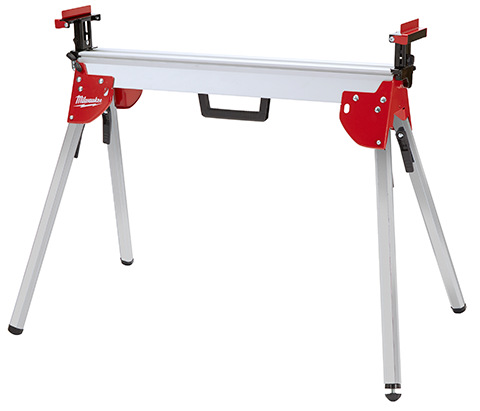
Second they improved the miter saw bracket. The old bracket used a clamp and lock mechanism, located on the front of the saw. We often found this location awkward, and difficult to balance the saw and operate the clamp. The new stand uses a spring lever that allows you to clip and “pressure-push” the saw down, and into place. This spring lever is also WAY faster, and easier to release the saw from the stand.
Third, the material support ends are no longer rollers with a vertical support pole held in place with a “weak,” thumb screw knob. On the older model, we had issues with heavy boards affecting the vertical adjustment. The newer design uses a square bracket with flat support that bears its load directly onto the support arm, making for a stronger attachment.
Lastly, they made it lighter and now offer a few cool accessories like a carry strap and clamp-on tabletop to improve the efficiency of the stand. So from first appearances, they improved the design and cut down the steps needed to set the stand-up and get going.
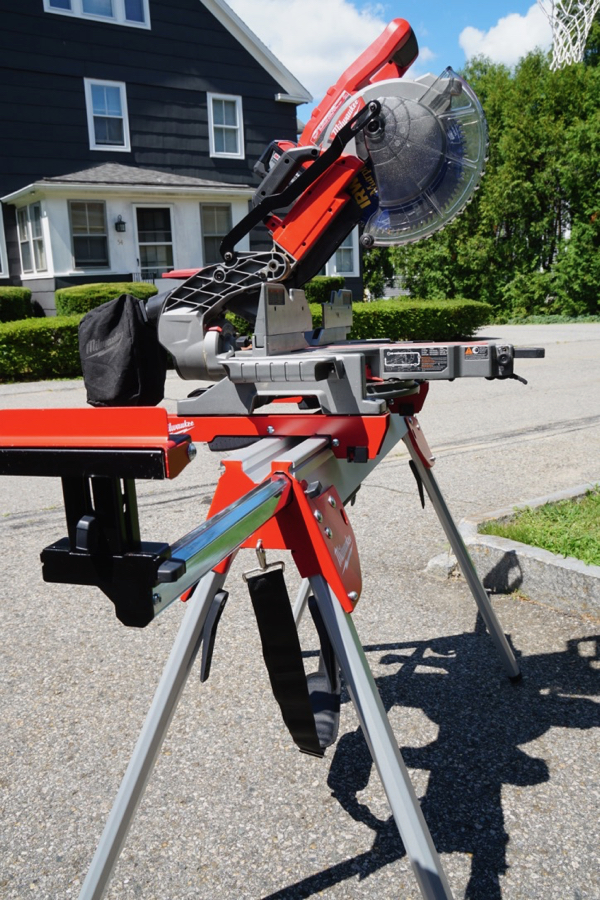
What Do We Think – Stand Design
We took the Milwaukee Miter Saw Stand to our job site to see how well it worked in the field. The new stand has a total weight of just 31 lbs, this is a plus for us since we’re carrying this in and out of a trailer each day. Resistant at first, I actually found myself using the carry straps and then using my free hand to carry something else. When set up the strap hangs safely below the saw, but could just as easily be clipped and stowed.
This stand has a 500 Pound rating and a pair of them would make great saw horses or low staging. Its robust tubular steel legs lock against a steel frame for strong leg-base support. We like that Milwaukee used steel in the legs, sacrificing weight for strength. Over the years I’ve seen sawhorses and miter saw stand legs damaged by lumber drops, vehicles backing into them, or being bumped. The top aluminum beam of the Milwaukee Miter Saw Stand has a groove that can accept a 2×4 on the edge which can be used as a board holder or sacrificial cut board.
Leg Lever and Pin
There are four spring-loaded levers, one for each leg. These levers operate a pin that is used to lock the legs open or folded closed for storage. We found these levers easy to use one-handed, and the pin had excellent alignment with a high tolerance in the metal locking hole. The legs swing in and out of the folded position smoothly, allowing you to open and close the stand as fast as you want. The one-handed operation was sorely needed and key for us!
Leg Cap Design
The legs have ABS plastic end caps to prevent marring of floor surfaces. One of the leg caps is adjustable, allowing a leveling feature. The fitment of these caps is a ribbed style, friction fit. In or experience these caps are the first thing to fall off and often result in the user having to tape them back on. We tested the end caps by dragging the stand, with the 10″ Milwaukee Miter saw attached across an asphalt surface. After several back and forth drags, we were able to dislodge one of the plastic caps. The cap was easily reinserted by hand and tapped in with a hammer.
I’m not sure how Milwaukee can improve on this design, but it’s an area they should continue to look to improve in.
Material Support Arms
The Milwaukee Miter Saw Stand has two, all-metal, material support arms that slide out from the main beam of the stand. These support brackets were strong enough to support most framing that we were cutting. We cut 14′ 2×6 framing with no deflection. To test the limits of this support arm, we tried squaring the edges of 2×12-10′ PT framing. This lumber was wet and heavy and we knew we were pushing the limits of the design by placing the majority of the boards’ weight on one support arm. During this test, we noticed some deflection.
The material support ends offer both material support and also a flip-up stop, for repetitive cuts. We liked that the end supports are flat and allow us to store the miter saw stand vertically, with a bungee cord, in our trailer. One issue we noticed when putting the stand together was the
lack of instructions on how to mount the material support-ends. There was no mention at all on which way they mount, or how to insert the bolt to mount it. After some fusing around we figured it out, I think.
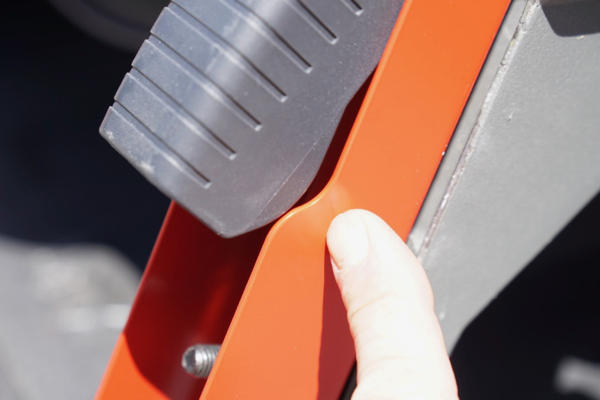
Milwaukee Miter Saw Stand – Saw Brackets
The saw comes with a bracket system that fits all brands of miter saws. The brackets are secured to your miter saw and allow you to clip the saw easily, on and off the stand. This new design is way faster than the older front-lever version and are situated in the back end of the bracket. Milwaukee placed the levers on the backside based on their own miter saw the design. Most people carry this miter saw by the handles and its both natural and intuitive to simply reach a few more inches to activate the levers. A time-saving design indeed.
NOTE – On one stand we tested we encountered an issue with the alignment of the spring release lever. The geometry of the handle is almost u-shaped and the bottom of the lever handle was hitting the red, metal bracket housing. This made opening the release impossible until the handle was bent back into the groove. Two other crew members also reviewing different stands did not have this issue.
We brought the matter to Milwaukee’s attention and they advised me that a “fix is already in place,” and that we must have received an older version. Since they discovered the issue they redesigned the geometry of the handle to extend deeper in the red metal channel, thus alleviating any risk of this occurring. A test on a replacement bracket set was fine, and we’ve had no issues since.
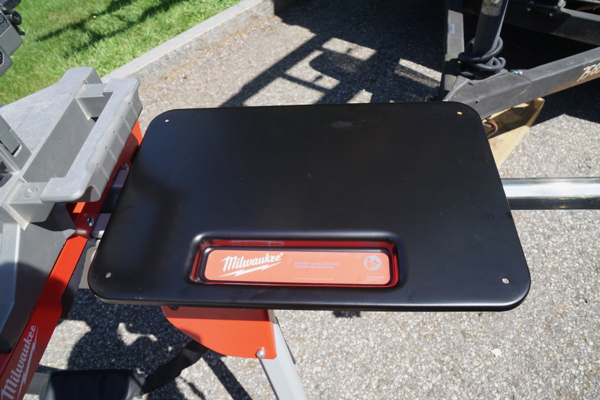 Accessory Table Top
Accessory Table Top
Because many tradesmen use their miter saw stands as work stations, Milwaukee designed an optional table top accessory surface. When attached, the accessory can hold tools, tapes, nails, and more. The tray is designed to sit below the plane of the miter saw cut-table, and can be installed offset so it can be mounted off to the side. We liked offsetting the table top because it allowed us to center the miter-saw. A recessed storage tray on the table accessory, keeps items from falling off the stand. We’d like to see this recessed tray magnetized.
NOTE- One of our tool testers had a problem with their tray getting wedged on too tight and had to use a hammer to remove it. Two of us, with different s
tands, had zero difficulty with our trays. Overall I liked having the tray and found myself placing my tape, and other items on it.
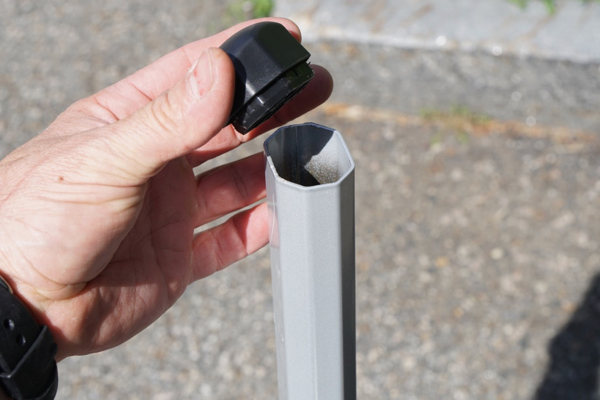
Improvement
We were impressed with the improvements made to this new stand. We’d like to see Milwaukee give the leg end-caps another look, but the biggest improvement to this stand can be achieved by improving the locking knobs. All of the knobs, on this stand, are cheap plastic thumb knobs. All the manufacturers use them and if Milwaukee wants to stand apart from their competitors they should consider all metal, aluminum knobs, or better yet levers. At a minimum Milwaukee should be using a lever for the material support arms lock.
Cost
- Milwaukee Miter Saw Stand $199
- Table Top $24.99 (48-08-0552)
- Carrying Strap $14.99 (48-08-0553)
- Additional Brackets $24.99 (48-08-0554)
Overall Impression
Do I recommend this stand? The answer is a definite yes! I currently use the older version of this stand and was actively looking for a replacement, in fact I was eying Dewalt miter saw stand. This new stand is a definite improvement for Milwaukee and one that will now replace my older design.
Milwaukee Miter Stand Video Review
About the author
2 Comments
Leave a comment
Disclosure
Product reviews on this site contain our opinion of a product or service. We will always strive for objectivity and transparency in our reviews. Our goal is to provide readers with honest, objective information based on our own experiences. We never have and never will accept payment in exchange for a positive review. Many of the products that we review are provided to us for free by a manufacturer or retailer. In some cases, we also have advertising or affiliate relationships with manufacturers and retailers of products and services we review. For additional information please visit our additional disclosure policies.











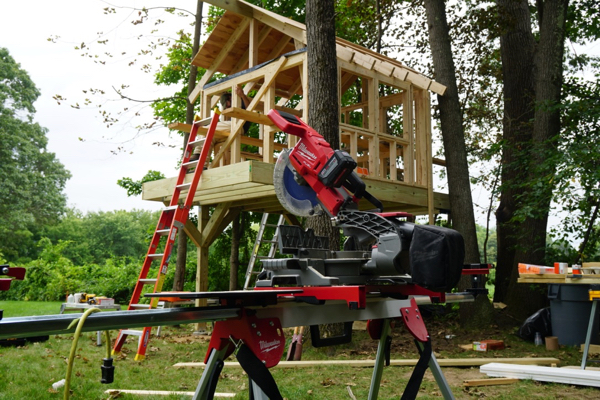
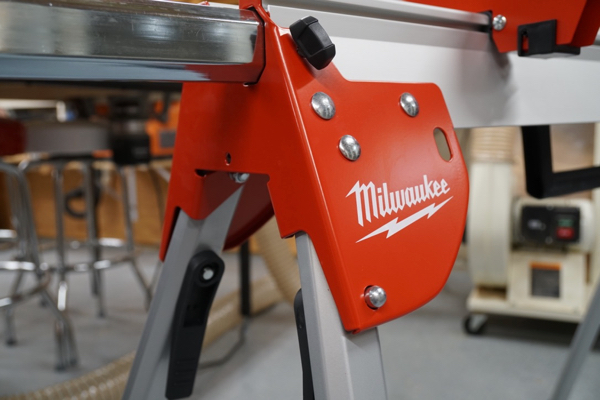
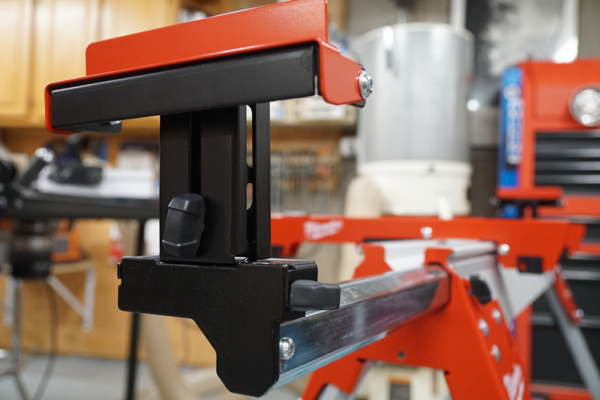
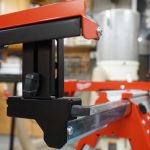
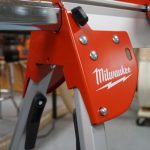
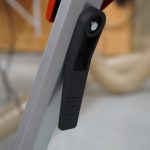
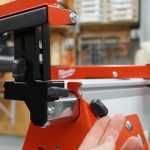
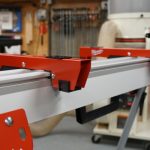
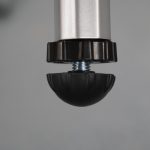
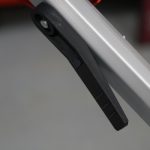
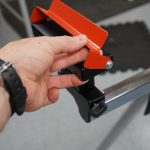
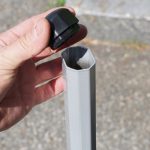
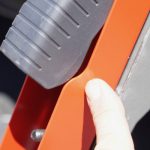
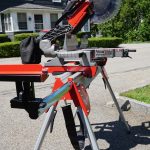
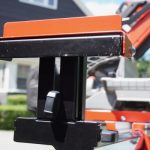
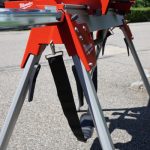
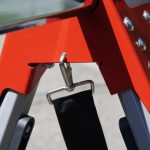
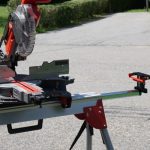
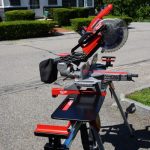
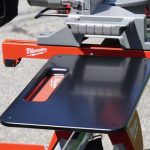
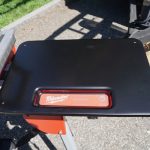
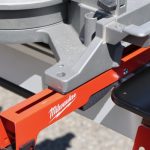
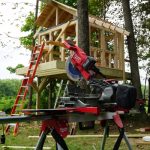












The minor saw Stan need Lag Leveler
THOSE PLASTIC FEET ON THE LEGS JUST MAKE THEM STICK UP INTO THE LEGS FARTHER.